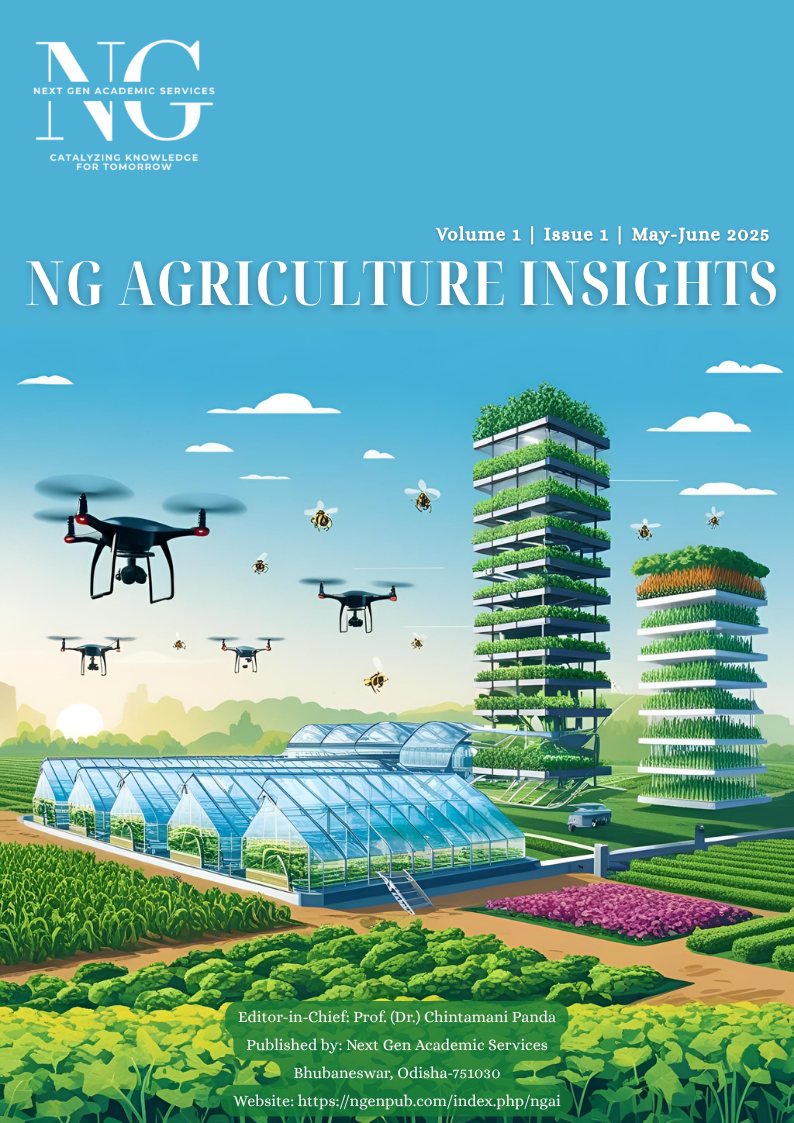Unlocking the Genetic Secrets of Disease-Resistant Vegetables
DOI:
https://doi.org/10.5281/zenodo.15713695Keywords:
Disease Resistance, Genetic Engineering, Genomics, Marker-Assisted Selection, Vegetable CropsAbstract
The genetic studies are very promising in coming up with disease-resistant vegetable crops, which is very crucial in contemporary agricultural research. New areas of genome sequencing, gene editing and marker assisted selection have provided scientists with the power to recognise, select and manipulate disease resistant related genes. It is these breakthroughs that have brought resilient vegetable varieties capable of cutting down the use of chemical pesticides, improved amount of harvest, and general profitability of farms. The combination of genetic engineering and other biotechnological features forms the sustainable route forward, as it helps to create environmentally friendly farming environment and provides the stable delivery of food. Further investment in genetic research and collaboration to the stakeholders is needed to settle ethical concerns and to reach the full potential of these technologies. The above developments also indicate the positive disruptive effects that genetic inventions have on agriculture as a harbinger of disease-free vegetables in the near future.
References
Cario, E. (2020). Recognition of microbe-associated molecular patterns by pattern recognition receptors. Principles of Mucosal Immunology, 269-283.
Cobb, J. N., Biswas, P. S., & Platten, J. D. (2019). Back to the future: revisiting MAS as a tool for modern plant breeding. Theoretical and Applied Genetics, 132, 647-667. https://doi.org/10.1007/s00122-018-3266-4
Ebert, A. W. (2020). The role of vegetable genetic resources in nutrition security and vegetable breeding. Plants, 9(6), 736. https://doi.org/10.3390/plants9060736
Gururani, M. A., Venkatesh, J., Upadhyaya, C. P., Nookaraju, A., Pandey, S. K., & Park, S. W. (2012). Plant disease resistance genes: current status and future directions. Physiological and molecular plant pathology, 78, 51-65. https://doi.org/10.1016/j.pmpp.2012.01.002
Kaur, B., Bhatia, D., & Mavi, G. S. (2021). Eighty years of gene-for-gene relationship and its applications in identification and utilization of R genes. Journal of genetics, 100(2), 50. https://doi.org/10.1007/s12041-021-01300-7
Mohapatra, P. P., Seleiman, M. F., Mandal, R., Pramanik, K., Maity, T. K., Tarafdar, J., ... & KHAN, N. (2023). Efficiency of RAPD and SSR markers in assessing genetic diversity in summer onion (Allium cepa L.) genotypes. Notulae Botanicae Horti Agrobotanici Cluj-Napoca, 51(3), 13369-13369. https://doi.org/10.15835/nbha51313369
Pradhan, K., Rout, S., Tripathy, B., Mishra, U. N., Sahoo, G., Prusty, A. K., & Dash, L. (2021). Role of Biotechnology in Vegetable Breeding. Turkish Online Journal of Qualitative Inquiry, 12(3).
Pramanik, K., Sahu, G. S., Acharya, G. C., Tripathy, P., Dash, M., Koundinya, A. V. V., ... & Moharana, D. P. (2024). Estimating phenotypic stability for relevant yield and quality traits in French bean (Phaseolus vulgaris L.) using AMMI analysis. Heliyon, 10(5). https://doi.org/10.1016/j.heliyon.2024.e26918
Sahoo, G., Wani, A., Rout, S., Sharma, A., & Prusty, A. K. (2021). Impact and contribution of forest in mitigating global climate change. Des. Eng, 4, 667-682.
Sandhya, D., Jogam, P., Allini, V. R., Abbagani, S., & Alok, A. (2020). The present and potential future methods for delivering CRISPR/Cas9 components in plants. Journal of Genetic Engineering and Biotechnology, 18(1), 25. https://doi.org/10.1186/s43141-020-00036-8
Shetty, M. J., Chandan, K., Krishna, H. C., & Aparna, G. S. (2018). Genetically modified crops: an overview. Journal of Pharmacognosy and Phytochemistry, 7(1), 2405-2410.
Tripathy, B., Rout, S., Mishra, U. N., Sahoo, G., Pradhan, K., Prusty, A. K., & Dash, L. (2021). Vegetables: a potential source of nutraceuticals. Annals of the Romanian Society for Cell Biology, 25, 17921-17941.
Downloads
Published
Issue
Section
License
Copyright (c) 2025 Priyadarshani P Mohapatra

This work is licensed under a Creative Commons Attribution 4.0 International License.





